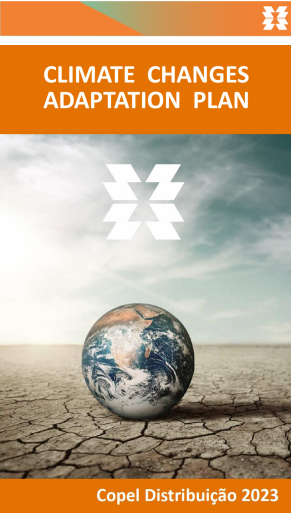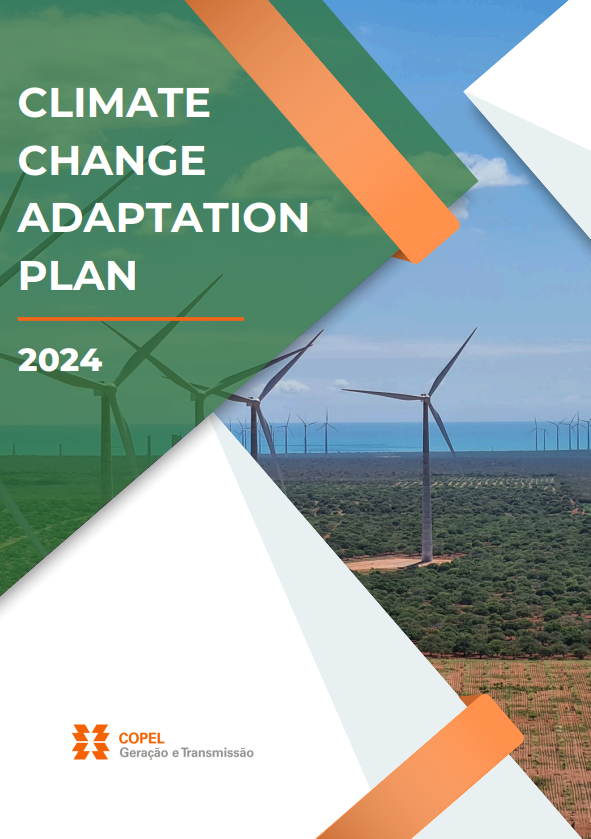Climate Change Impact Management
Climate change main impacts to Copel business are related to temperature, wind and rain historical patterns.
The water crisis, caused by lack of rain for long periods within a specific region, decreases considerably the reservoir level and the power generation, even though it can be mitigated due to the country ́s continental dimensions and the existence of a national interconnected system that enables offset.
The wind speed, even though it has positive impact for wind power stations, is damaging to power transmission and distribution lines.
Due to that, Copel has a risk management process that incorporates the impacts caused by climate change, in order to prevent, decrease, mitigate and adapt the Company activities to climate changes and extreme events.

Climate Change Risk Management
Meteorological events of high intensity in a short period of time, such as heavy rainfall, gusts of wind and lightning, have become more frequent and more severe, and can cause physical damage to structures and facilities of generation, transmission and distribution of energy, leading to interruption of supply, in addition to operational costs to rebuild the system.
The scarcity of rainfall can compromise the storage of the reservoirs of Copel’s hydroelectric plants, resulting in a temporary reduction in the Company’s generation capacity, whose potential is predominantly from hydraulic sources.
Considering water resource use priorities set forth in Law no. 9433/1997, in case of lack of water, human consumption and animal thirst-quenching are priorities, thus hydroelectric power generation is changed and reservoirs start to supply priority conditions.
Monthly average precipitation changes, that can cause affluent average flow increase to power stations operated by Copel, and they can also provide impacts, including structure sizing review requirement, in order to increase its capacity due to new data and improvement generation physical assurance increase.
Intense wind action (above 70 km/h) impacts the company physical structures, causing distribution (high and medium voltage) and transmission interruptions, causing financial impacts and team commissioning.
Temperature increase enabled consumption increase due to intense use of chilling and air conditioning equipment, and it enforces restrictions electrical installations rated capacity.
Transmission and distribution lines are built to operate within a specific project temperature, which considers room temperature and cable heating caused by electric current flow. As room temperature increases, power current flow needs to be decreased to offset temperature decrease.
In order to follow climate phenomenon development in real-time, Copel relies on a sophisticated weather numeric forecast system, with the routine operation of the North-American numeric template Weather Research and Forecasting (WRF), supplied by local data and North-American global template GFS borders.
The main corporate risks are identified based on strategic benchmarks, climate scenarios, and internal and external environments, in a detailed process described in Risk Management. Since 2022, climate risks have been assessed separately from social and environmental risks. The risk map considers physical risks and transition risks. Climate risk assessment covers the company’s direct operations and its upstream and downstream chain. Among the risks considered are:
Main risks involving Copel’s business and its subsidiaries | |||
Physical risks |
| Potential impacts | Mitigation initiatives |
Physical, acute | Cyclone, tornado, hurricane | Strong winds can damage the Company’s transmission lines and distribution networks. | Short-term initiatives include meteorological monitoring and procedures, aiming to restore the electrical system as quickly as possible. Additionally, planning includes investments geared towards a robust and secure network, with technologies that minimize the impact, frequency and duration of outages, meaning the energy supply can be restored more quickly. Our key initiatives are: Rural Three-Phase Program, Smart Grid Program, Urban Forestry Program. |
Flash floods | The occurrence of heavy rains can affect the hydrological regime and trigger risk situations for the energy generation business operations. | Copel has devised a Dam Safety Plan that includes structure monitoring procedures, inspections, periodic safety reviews, and the establishment of Emergency Action Plans for dams and socio-environmental actions. There are also emergency action plans against floods with periodic drills. | |
Physical, chronic | Temperature changes | Warmer weather tends to increase energy consumption due to greater use of air conditioning. Under these conditions, the load limit of high-voltage distribution lines is reduced to preserve the thermal balance of the conductors and ensure cables remain at a safe height above the ground. | Copel relies on studies to revise the ambient temperature value used to evaluate the loading of distribution lines in expansion planning studies, aiming for greater operational safety. |
Transition risks |
| Potential impacts | Mitigation initiatives |
Current regulations |
| The growing popularity of micro and mini-distributed generation grids with credit offsets can lead to distributor over-contracting. The need to adapt the existing electrical grid due to regulatory changes motivated by climate issues may lead to unprovisioned financial investments or administrative sanctions from the regulatory agency | Monitoring, tracking, and participating in discussions on the topic in forums promoted by sector entities and associations. |
Emerging regulations |
| Establishment of a regulated carbon market in the country, which, by definition, sets greenhouse gas reduction targets, may impact the company’s offsetting costs. | Monitoring, tracking, and participating in discussions on the topic in forums promoted by sector entities and associations. The Company established its Neutrality Plan in 2021 aiming to minimize Scope 1 emissions from its operations. |
Technology |
| Ability to keep up with the speed and pace at which innovative low-carbon products and services are required. | Monitoring market trends, executing R&D projects, the Copel Volt open innovation program, creating a corporate venture capital fund for energy techs, startups focused on new renewable energies. |
Legal |
| Potential increase in litigation, driven by power supply outages, due to the heightening of acute physical risks in power grids (rain, wind and lightning). | Investment in a new management system to expand and modernize customer service for the distributor’s entire customer base and implementing the Smart Grid Program, which aims to automate the distribution network, seeking to reduce downtime and allowing real-time monitoring, along with other actions related to distribution assets. |
Reputational |
| Potential impacts on Copel’s image due to the increase in the number of severe weather events and the intensification of their effects. | |
Market |
| Possibility of impacts on the energy trading price in the free market due to the influence of rainfall conditions. | Carrying out studies and analysis and adopting processes and systems for risk mitigation and portfolio diversification through the inclusion of other energy generation sources, such as solar and wind. |
Climate Change Adaptation
The Company has an Adaptation Subcommittee to discuss and propose a risk survey methodology related to climate change to the areas responsible for power generation, transmission and distribution processes.
As a Climate Change Adaptation measure, Copel develops actions with the purpose of mitigating climate change effects, including criteria review used in new undertaking projects, which are reviewed on a daily basis, and according to the region to be implemented. Project deployment is prioritized with more robust structure and higher wind resistance, following actual data and future extrapolations for each region surveyed.
Copel intends to anticipate measures to minimize such risk impact, using contingency support structures, meteorological monitoring performance, and providing on-call staff to work in the system recomposition as soon as possible, whenever required.
For heavy rain situation, Copel has emergency action plans for its hydropower undertaking dams, in which actions to be executed in case of anomaly are set forth, identifying preventive and corrective procedures.
Moreover, it keeps a hydro-climatological station network and ongoing weather forecast services, providing satellite and meteorological radar images and quantitative forecasts within the regions the Company has facilities.
Distribution Business
Aligned with the Company’s strategic guidelines, Copel Distribuição prepared the Climate Change Adaptation Plan in order to guide decision-making regarding the necessary and priority investments in the facilities, as well as the implementation of improvements in the subsidiary’s undertakings.
In addition to the analysis of climate scenarios, future projections and risks, the document addresses the management of emissions and targets, in accordance with the commitments made.
Generation and Transmission Business
Aligned with the Company’s strategic guidelines, Copel Geração e Transmissão prepared the Climate Change Adaptation Plan in order to guide decision-making regarding the necessary and priority investments in the facilities, as well as the implementation of improvements in the subsidiary’s undertakings.
In addition to the analysis of climate scenarios, future projections and risks, the document addresses the management of emissions and targets, in accordance with the commitments made.





